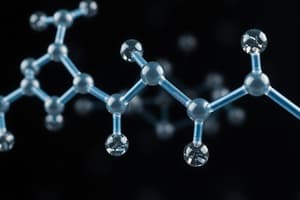Podcast
Questions and Answers
What is the maximum number of monosaccharide units that an oligosaccharide can contain?
What is the maximum number of monosaccharide units that an oligosaccharide can contain?
- 10 (correct)
- 5
- 1
- 15
Which statement accurately describes polysaccharides?
Which statement accurately describes polysaccharides?
- They include only disaccharides.
- They are formed from 6-10 monosaccharide units.
- They contain more than 10 monosaccharide units. (correct)
- They consist of 1-5 monosaccharide units.
If oligosaccharides are composed of few monosaccharide units, what does 'oligo' mean in Greek?
If oligosaccharides are composed of few monosaccharide units, what does 'oligo' mean in Greek?
- Few (correct)
- Complex
- Many
- One
How many monosaccharide units must a molecule contain to be classified as a polysaccharide?
How many monosaccharide units must a molecule contain to be classified as a polysaccharide?
Which of the following best describes oligosaccharides?
Which of the following best describes oligosaccharides?
How are carbohydrates categorized based on the number of monosaccharide units?
How are carbohydrates categorized based on the number of monosaccharide units?
What is a trisaccharide?
What is a trisaccharide?
Which of the following classifications represents a carbohydrate with four monosaccharide units?
Which of the following classifications represents a carbohydrate with four monosaccharide units?
What term is used to describe carbohydrates that consist of multiple monosaccharide units?
What term is used to describe carbohydrates that consist of multiple monosaccharide units?
Which statement about disaccharides is true?
Which statement about disaccharides is true?
Flashcards
Oligosaccharides
Oligosaccharides
Carbohydrates composed of 2 to 10 monosaccharide units.
Polysaccharides
Polysaccharides
Carbohydrates composed of more than 10 monosaccharide units.
Monosaccharides
Monosaccharides
The fundamental building blocks of carbohydrates.
Carbohydrates
Carbohydrates
Signup and view all the flashcards
Number of monosaccharides
Number of monosaccharides
Signup and view all the flashcards
Monosaccharide units
Monosaccharide units
Signup and view all the flashcards
Disaccharide
Disaccharide
Signup and view all the flashcards
Trisaccharide
Trisaccharide
Signup and view all the flashcards
Classification of carbohydrates
Classification of carbohydrates
Signup and view all the flashcards
Study Notes
Carbohydrates
- Definition: Biomolecules found abundantly in living organisms, having a wide range of functions, including providing energy, acting as energy storage molecules, forming cell membrane components, and mediating communication between cells.
Carbohydrates - Chemical Nature
- Composition: Contain the elements carbon, hydrogen, and oxygen. Often written as CnH2nOn or (CH2O)n, where n > 3.
- Structure: Polyhydroxy aldehydes or ketones, or compounds that yield these on hydrolysis.
Carbohydrates - Classification
- Monosaccharides: Simplest form, also known as simple sugars. Cannot be hydrolyzed further. Colorless, crystalline solids soluble in water, insoluble in non-polar solvents. Possess either an aldehyde or ketone group. Classified by the number of carbon atoms (e.g., trioses, tetroses, pentoses, hexoses...).
- Oligosaccharides: Compounds yielding 2 to 10 monosaccharide molecules upon hydrolysis. Monosaccharide units are joined by glycosidic linkages. Classified based on the number of monosaccharide units (e.g., disaccharides, trisaccharides...).
- Polysaccharides: Contain more than 10, sometimes hundreds, of monosaccharide units. Yield more than 10 monosaccharide molecules upon hydrolysis. Differ from each other in monosaccharide identity, chain length, branching, and bond types. Important functions include structural components (e.g., cellulose, bacterial cell walls) and energy storage (e.g., glycogen, starch).
Examples of Monosaccharides: Glucose
- Molecular Formula: C6H12O6
- Properties: Main energy source, aldohexose, glucopyranose, dextrose, reducing sugar, grape sugar.
- Structure: D-Glucose and L-Glucose are stereoisomers, differing in spatial arrangement around the chiral centers.
Naming of Monosaccharides
- Naming scheme: Prefix based on carbon count (e.g., tri-, tetra-, pent-), plus suffix "-ose" (e.g., triose, tetrose, pentose).
Examples of Carbohydrates
- Disaccharides: Sucrose (glucose and fructose), lactose (galactose and glucose), maltose (glucose and glucose).
- Trisaccharides: Raffinose, stachyose
- Polysaccharides: Starch, glycogen, cellulose
Properties of Carbohydrates
- Some of their properties include Stereoisomerism and Optical activity.
Functions of Carbohydrates
- Energy source: Used to fuel cellular reactions. Most abundant dietary energy source for all living beings (4 kcal/gram).
- Structural components: Form protective and structural components, such as in plant cell walls (cellulose).
- Intermediates: Act as metabolic intermediates. Intermediates in biosynthesis of fats and proteins.
- Energy source for brain and nerve tissue.
- Surface antigens and receptors: Combine with lipids and proteins to form important biomolecules like surface antigens, receptors, vitamins, and antibiotics.
- Storage: Serve as storage forms, such as glycogen and starch.
Studying That Suits You
Use AI to generate personalized quizzes and flashcards to suit your learning preferences.
Related Documents
Description
This quiz explores the chemical nature of carbohydrates, defining their role as biomolecules in living organisms. You will learn about their composition, structure, and the classification of different types such as monosaccharides and oligosaccharides. Test your knowledge on these essential biomolecules!




